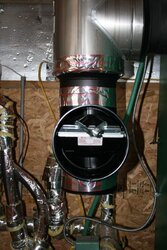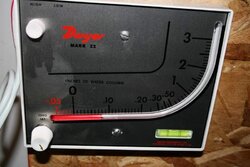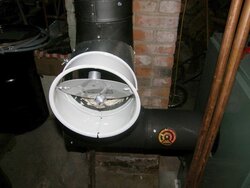The New Yorker I have is similar, I think, to the Memco unit you have. New Yorker says to put the barometric damper in. They're pretty specific about wanting the draft less than .04 inches at "most".
Is it "safe"? Is burning wood "safe"? If it was, everybody would likely still be doing it. It's not as "safe" as burning oil, gas, or electric heat.
All oil burners must have a barometric damper, adjusted according to the manufacturers instructions, to be code compliant.
If your solid fuel boiler, regardless of the make and model, has an instruction manual that says, "Install barometric damper.... within x-inches of the boiler... and adjust to no more than .0x inches of draft" you need one to be code compliant.
If you install one, keep the chimney connector pipe clean. Use ACS or some other chemical catalyst to help keep the chimney clean. Clean the chimney regularly, and diligently.
I went through the process of not having one, then installing one. So far, I like the results. Conventional water jacket boiler design. I like burning coal in it, but nights like tonight when there is little to no idle time, I am putting pieces of trees into it. It's running mostly all the time, no idling for long periods. Is it without risk? No.
However... the risk is mitigated by the fact that I am less likely to have a chimney fire with the damper in place.
Why?
1. Less "dirty" smoke than before. Without the damper, the fire was burning in a vacuum, even when the combustion blower was running. Belched black, thick, smoke the entire time there was a wood fire in it. Prone to "puffbacks" and coal gas explosions.... dirty fire... took a long time to come up to temperature. Now, once the fire gets established after loading, there is little smoke out of the chimney. Stack velocity is through the roof so little stagnation happens in the chimney. It shoots up the chimney with the draft and doesn't stay around long enough to be deposited in the chimney. Without the damper, it was kind of hanging around in there... bound to get more deposits if it's just farting around all the way up the chimney.
2. The smoke and gasses are hanging around in the boiler longer, allowing them to burn more completely, and heating the boiler up faster.
3. I asked myself and others the same question... and decided based on my situation, my choice was "when" I had a chimney fire without the damper, versus "if" I had a chimney fire with one.
4. Watch your stack temperatures, draft, and combustion air control, if you put one in. Keeping the stack temperatures below autoignition temperature for creosote and not having flame extension into the stack reduce the chances of a chimney fire drastically. Because of the damper allowing room air into the gas stream before it enters the chimney, I'd be completely stunned to see a chimney fire unless I allowed a large accumulation of creosote deposits to accumulate in the connector pipe and adjusted the combustion air too high and overheated the pipe. A chimney pipe fire appears to be virtually the only way I'll get fire into the chimney.
Smee said:
Your barometric damper install has got me wondering....
Is there a down-side to having a barometric damper?
Suppose you have a chimney fire. Would the damper then become a source of air to fan a chimney fire?
Reason I'm asking is because I have a very tall 3-flue chimney -- 3 stories plus. It draws like crazy. I used to think this was an unadulterated good thing. But now I wonder if maybe I don't have too much of a good thing for my Memco boiler, because it is pradtically impossible to slow the thing down. The boiler draft control is not exactly air-tight (understatement). There's a conventional damper in the stove pipe, which helps. But to get any results, you have to be pretty agressive with it: 10 -- 11 oclock. That gets rid of some of the roaring sound. But there is a very fine line. Cross it, (somewhere past 11 oclock) and the furnace goes quiet, but you get smoke out the joints in the elbow. There is no middle ground.
So maybe a (properly adjusted) barometric damper would cut down on the draft enough to allow the Memco to just burn quietly without all the sound effects. The oil burner on the other side of the chimney has a barometric damper. Is this an indication that maybe I should have one on the wood boiler side?
Hope this doesn't count as a thread hy-jack. If so, my appologies.






